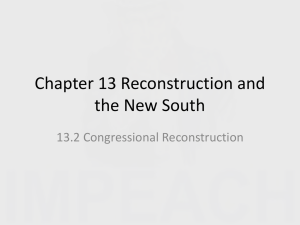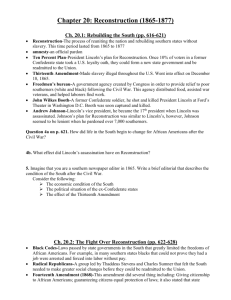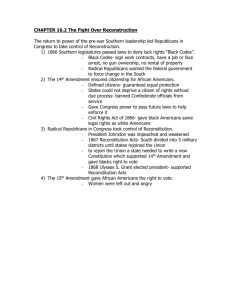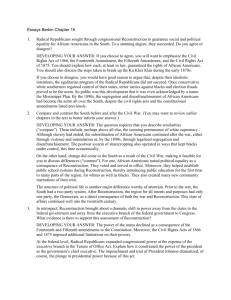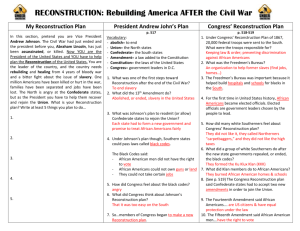II. Reconstruction Declines
advertisement
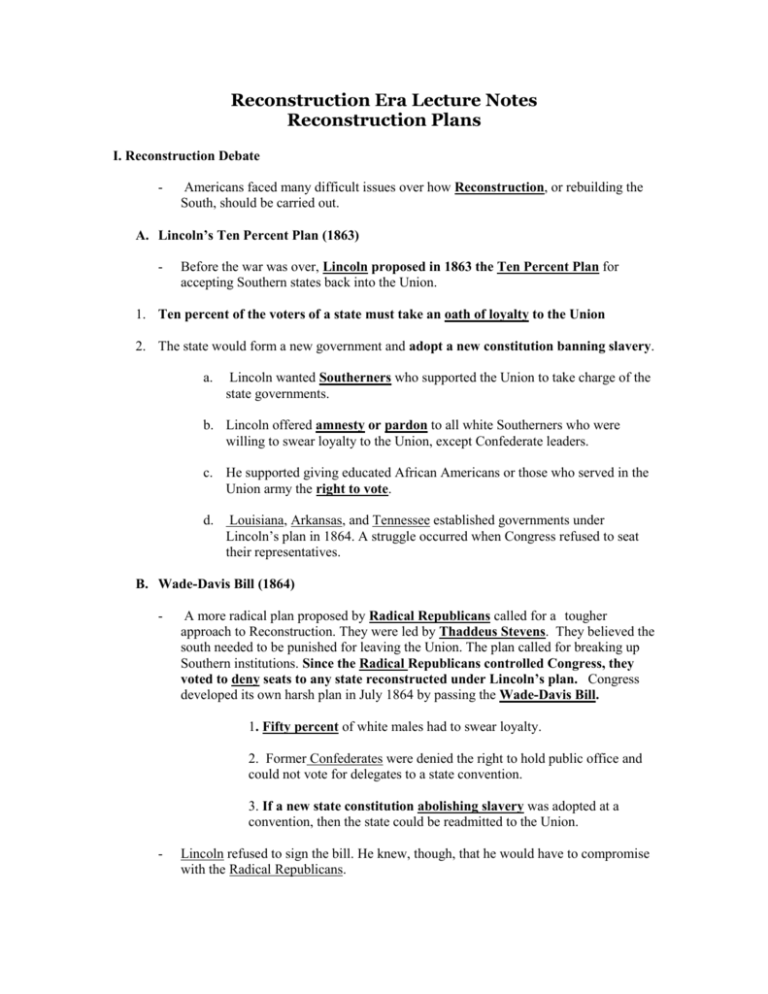
Reconstruction Era Lecture Notes Reconstruction Plans I. Reconstruction Debate - Americans faced many difficult issues over how Reconstruction, or rebuilding the South, should be carried out. A. Lincoln’s Ten Percent Plan (1863) - Before the war was over, Lincoln proposed in 1863 the Ten Percent Plan for accepting Southern states back into the Union. 1. Ten percent of the voters of a state must take an oath of loyalty to the Union 2. The state would form a new government and adopt a new constitution banning slavery. a. Lincoln wanted Southerners who supported the Union to take charge of the state governments. b. Lincoln offered amnesty or pardon to all white Southerners who were willing to swear loyalty to the Union, except Confederate leaders. c. He supported giving educated African Americans or those who served in the Union army the right to vote. d. Louisiana, Arkansas, and Tennessee established governments under Lincoln’s plan in 1864. A struggle occurred when Congress refused to seat their representatives. B. Wade-Davis Bill (1864) - A more radical plan proposed by Radical Republicans called for a tougher approach to Reconstruction. They were led by Thaddeus Stevens. They believed the south needed to be punished for leaving the Union. The plan called for breaking up Southern institutions. Since the Radical Republicans controlled Congress, they voted to deny seats to any state reconstructed under Lincoln’s plan. Congress developed its own harsh plan in July 1864 by passing the Wade-Davis Bill. 1. Fifty percent of white males had to swear loyalty. 2. Former Confederates were denied the right to hold public office and could not vote for delegates to a state convention. 3. If a new state constitution abolishing slavery was adopted at a convention, then the state could be readmitted to the Union. - Lincoln refused to sign the bill. He knew, though, that he would have to compromise with the Radical Republicans. C. Lincoln Assassinated - The country mourned the death of a man who saved the Union and helped African Americans win freedom. On the evening of April 14, 1865, President Lincoln was shot while attending a play “Our American Cousin” at the Ford’s Theater in Washington, D.C. His assassin, John Wilkes Booth, entered the box Lincoln was sitting in, shot him in the back of the head, and escaped. Lincoln died a few hours later at the home of a nearby tailor. D. Johnson’s Plan (1865) - Vice President Andrew Johnson became the president. As a former senator, he was the only Southern senator to support the Union. He called his plan for the South “Restoration.” 1. Majority of Southerners must swear allegiance to the Union and then would be granted amnesty. 2. High-ranking Confederate officials and wealthy landowners could only be pardoned by applying personally to the president. This was his way of attacking the wealthy leaders who he thought tricked Southerners into seceding. 3. The president would appoint governors and require them to hold elections for state constitutional conventions. Former Confederate officials could vote and hold office. 4. Only whites that swore their loyalty and had been pardoned would be allowed to vote. 5. Before a state could reenter the Union, its constitutional convention had to denounce secession and abolish slavery. 6. States had to ratify the Thirteenth Amendment passed in January 1865 that abolished slavery. - By the end of 1865, Johnson declared Restoration was almost complete because all the former Confederate states had established new governments and were ready to rejoin the Union. E. Radical Reconstruction (1867) - Radical Reconstruction was the period that began when Congress passed the Reconstruction Acts. The First Reconstruction Act, passed on March 2, 1867 1. Created new governments in the ten Southern states that had not ratified the Fourteenth Amendment. Tennessee was quickly readmitted to the Union because it had ratified the amendment. The ten states were divided into five military districts under the command of military officers. 2. African American males were guaranteed the right to vote in state elections. 3. Former Confederate leaders could not hold political office. 4. To be readmitted, each state had to ratify the Fourteenth Amendment and submit its new state constitution to Congress. - The Second Reconstruction Act was passed a few weeks later. It required military commanders to begin registering voters and to prepare for new state constitutional conventions. - By 1868 seven Southern states had established new governments and met the conditions for readmission. They were Alabama, Arkansas, Georgia, Florida, Louisiana, North Carolina, and South Carolina. By 1870 the final three states restored to the Union were Mississippi, Virginia, and Texas. Changes in the South I. African American Rights A. Freedmen’s Bureau - A difficult issue of Reconstruction was how to help freed African Americans. A new government agency, the Freedmen’s Bureau, was established to help former enslaved persons. It distributed food and clothing, provided medical services, and established schools staffed mostly by teachers from the North. It helped African Americans buy land, get jobs, and receive fair wages. It also gave aid to new African American higher institutions of learning, such as Atlanta University, Howard University, and Fisk University. B. Black Codes - The new Southern states passed a series of laws in 1865 and early 1866-called black codes. These laws reestablished slavery in disguise. They deprived freed people of their rights and enabled plantation owners to exploit African American workers. 1. Some laws allowed local officials to arrest and fine unemployed African Americans and make them work for white employers to pay off their fines. 2. Other laws banned African Americans from owning or renting farms. 3. One law allowed whites to take orphaned African American children as unpaid apprentices. C. Civil Rights Act of 1866 - Congress challenged the black codes. It extended the life of the Freedmen’s Bureau in1866 and granted it the power to set up special courts to prosecute people charged with violating the rights of African Americans. It also passed the Civil Rights Act of 1866, giving full citizenship to African Americans, and gave the federal government the right to intervene in state affairs to protect them. It overturned black codes and contradicted the 1857 Supreme Court Dred Scott decision saying that African Americans were not citizens. - Johnson vetoed both bills. However, Republicans were able to override both vetoes and the bills became law. This split between the president and the Radical Republicans led Congress to draft the new Reconstruction Plan. (Radical Reconstruction) D. Fourteenth Amendment - In June 1866 Congress passed the Fourteenth Amendment to the Constitution granting full citizenship to all individuals born in the United States. The amendment also says that no state can take away a citizen’s life, liberty, and property “without due process of law.” Every citizen was also entitled to “equal protection of the laws.” 1. It did not include voting rights for African Americans. 2. It also barred certain former Confederates from holding national or state office unless pardoned by a two-thirds vote of Congress. - Congress declared that Southern states must ratify the amendment in order to be readmitted to the Union. Because Tennessee was the only state to ratify early, adoption of the amendment was delayed until 1868 when the other ten states finally ratified it. II. Battle between President and Congress A. Tenure of Office Act - The rift between Congress and President Johnson grew wider. Congress passed the Tenure of Office Act in March 1867 to limit the president’s power. It prohibited him from removing government officials without the Senate’s approval. - When Congress was not in session in August 1867, Johnson suspended his secretary of war, Edwin Stanton. When the Senate met again and refused to approve this act, Johnson fired Stanton. Johnson also appointed as commanders of Southern military districts some generals whom the Radicals opposed. B. Johnson’s Impeachment - Because of Johnson’s actions, the House voted to impeach or bring charges against him. The case went to the Senate for a trial that lasted three months. 1. His defenders said he was exercising his right to challenge laws he thought unconstitutional. They said the impeachment was politically motivated and that Congress was trying to remove him from office without accusing him of a crime. 2. His accusers argued that Congress should retain the power to make laws. A senator from Massachusetts said that Johnson had turned “the veto power into a remedy for ill-considered legislation . . . into a weapon of offense against Congress.” 3. The Senate vote was one vote short of the two-thirds majority needed to convict, so Johnson remained in office until March 1869. C. Presidential Election of 1868 - The 1868 presidential election was a vote on Reconstruction. Most states had rejoined the Union by the election. Americans chose Republican and former Northern general Ulysses S. Grant as their new president. III. Republicans Take Charge A. The Republican Party - The Republican Party consisted of three main groups that dominated Southern politics: African Americans, white Southerners who supported Republican policies, and white settlers from the North who moved to the South. B. Fifteenth Amendment - A major piece of Reconstruction legislation was the Fifteenth Amendment. It prohibited the state and federal governments from denying the right to vote to any male citizen because of race, color, or previous condition of servitude. It became law in February 1870. The Republicans thought that the power of the vote would allow African Americans to protect themselves. C. Elections End 1. African Americans held important positions but did not control the government of any state. Between 1869 and 1880, sixteen African Americans served in the House and two in the Senate. a. Hiram Revels was elected to the Senate from Mississippi in 1870 and served one year. b. Blanche K. Bruce was the other senator, also from Mississippi, who was elected in 1874 and served six years. IV. Some Improvements A. Education Reconstruction brought important changes, especially in education. African Americans created their own schools in some regions. The Freedmen’s Bureau and private charities spread the value of education. Free African Americans from the North and Northern women taught in the schools. By 1870 about 4,000 schools existed and more than half the teachers were African Americans. Public school systems for both races were created in the 1870s. Generally whites and African Americans attended different schools.(segregation) B. Sharecropping Most African Americans were not able to buy their own land. Instead, they rented a plot of land from a landowner along with a shack, some seed, and tools. They became sharecroppers. Sharecropping was not much better than slavery for many because in return for the use of the land, the sharecroppers had to pay the landowner by giving him a share of the crops they grew. Barely anything was left for their families, and they rarely had enough to sell and to make any money. The End of Reconstruction I. Southern Opposition A. Scalawags, Carpetbaggers and the Ku Klux Klan 1. The Confederates called some Southern whites who had opposed secession and were non-slave holding farmers or business leaders scalawags or scoundrels. They hated them for siding with the Republicans. 2. Many Northern whites who moved to the South and supported the Republicans were called carpetbaggers by their critics. They got the name because they carried suitcases made of carpet fabric with all their belongings. Others were reformers who wanted to help reshape Southern society. 3. During Reconstruction secret societies committed violence against African Americans and white supporters of African Americans. The Ku Klux Klan, formed in 1866, killed them and burned their homes, churches, and schools. The Klan’s supporters were Southerners, especially planters and Democrats who wanted to reestablish white supremacy and saw violence as a way to attack Republicans. II. Reconstruction Declines A. As Southern Democrats began to regain political and economic control in the South, support for Radical Reconstruction policies decreased. Many Northerners also began believing in the end of Reconstruction. They thought it was holding back Southern economic expansion. B. Grant was reelected in the 1872 presidential election despite division in the Republican Party. Reports of corruption in Grant’s administration and in Reconstruction programs caused a group of Republicans to form the Liberal Republicans. Grant won. C. Congress passed the Amnesty Act in May 1872 that pardoned most former Confederates. This caused the political balance in the South to change and allowed Democrats to regain power. During the 1872 election, Liberal Republicans called for expanded amnesty for white Southerners. D. Democrats regained control of state governments in Virginia and North Carolina. The Ku Klux Klan and other violent groups terrorized Republican voters, thus helping Democrats take power. The Democrats used threats to pressure white Republicans to become Democrats. They also used violence to persuade African Americans not to vote. By 1876 Florida, South Carolina, and Louisiana were the only Southern states to remain Republican. E. Scandals and corruption charges weakened the Republican Party. The nation was also in an economic depression. Blame fell on the Republicans. In the 1874 congressional elections, the Democrats won control of a part of the federal. Turn III. The End of Reconstruction A. Presidential Election of 1876 - The disputed election of 1876 confirmed the Republican candidate Rutherford B. Hayes the winner four months after the election. Samuel Tilden, the Democrat, appeared the winner, but disputed returns from Florida, Louisiana, and South Carolina changed the result. A special commission was appointed to resolve the election. It awarded all 20 disputed electoral votes to Hayes, giving him the required majority for victory. Congress confirmed the commission’s findings, so Hayes became president although he had fewer popular votes than Tilden did. B. Compromise of 1877 - Congressional leaders made a deal to settle the election. This was the Compromise of 1877. It said that the new government would give more aid to the South and withdraw all remaining troops while the Democrats promised to maintain the rights of African Americans. - Hayes sent a clear message in his Inaugural Address that Reconstruction was over. The federal government would no longer attempt to reshape Southern society or help African Americans. C. Democrats in Charge - A new ruling party, the Democrats, took over. Many of these people were merchants, bankers, industrialists, and other business leaders who supported economic development and opposed Northern interference. They were conservatives. They called themselves “Redeemers” because they saved themselves from Republican rule. Policies included lower taxes, less public spending, and reduced government services. Many social services that had started during Reconstruction were cut or eliminated, including public education. D. A Divided Society 1. Voting Restrictions - Southern states imposed voting restrictions even though the Fifteenth Amendment prohibited any state from denying the right to vote because of race. a. Many states required people to pay a poll tax before voting. Because many African Americans and poor whites could not afford to pay the tax, they could not vote. b. Many states required prospective voters to also take a literacy test. Because African Americans had little education, they could not pass the test and therefore could not vote. c. Some states passed a grandfather clause to enable some whites who may not have been able to pass the test to be able to vote. The law said that if their fathers or grandfathers had voted before Reconstruction, they were also allowed to vote. African Americans were excluded because they did not gain the right to vote until 1867. 2. Segregated Society - The South became a segregated society. Many states passed Jim Crow laws, which were laws that required African Americans and whites to be separated in almost every public place and facility. The facilities were separate but not equal. Southern states spent more money on schools and facilities for whites than for African Americans. This segregation lasted for more than 50 years. IV. Various Acts A. The Homestead Act was passed in 1862 by the US Congress, which gave 160 free acres of land on the Great Plains to any settler who paid a filing fee and live on the land for 5 years. Thousands of new settlers moved to the Great Plains and lay claim to the free land. Married women could not claim land but single women had the same rights as men and took advantage of the Homestead Act. Most of the new settlers became farmers and were called sodbusters because they built their homes out of sod because of the lack of wood. B. The Dawes Act was passed in 1887 and broke up the reservations to end the individual identification with a particular Indian tribe. Each Native American was given a plot of reservation land and was encouraged to become farmers. Eventually they would become American citizens. Over the next 50 years, the reservations were broken apart and sold off mostly to speculators. C. The Morrill Act of 1862 was also known as the Land Grant College Act. It was a major boost to higher education in America. The grant was originally set up to establish institutions in each state that would educate people in agriculture, home economics, mechanical arts, and other professions that were practical at the time. The land-grant act was introduced by a congressman from Vermont named Justin Smith Morrill. He envisioned the financing of agricultural and mechanical education. He wanted to assure that education would be available to those in all social classes. There were several of these grants, but the first passed in 1862. This bill was signed by Abraham Lincoln on July 2. This gave each state 30,000 acres of public land for each Senator and Representative. These numbers were based on the census of 1860. The land was then to be sold and the money from the sale of the land was to be put in endowment fund, which would provide support for the colleges in each of the states.


